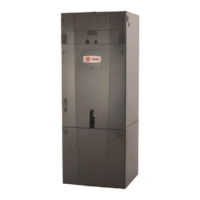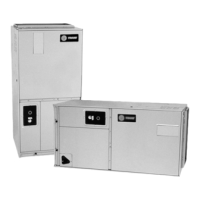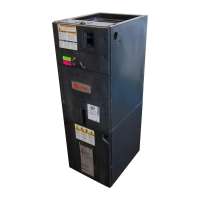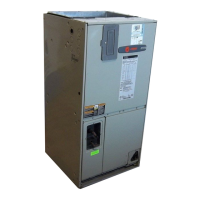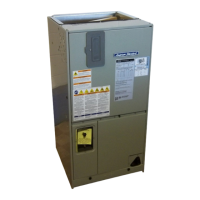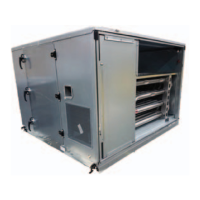Maintenance
RRU-SVX01E-EN 47
Evaporator and General Coil Cleaning
Procedures for Slab Coils
1. Disconnect unit power.
2. Remove enough panels and parts to gain access to the
coil.
3. Straighten coil fins with a fin rake if necessary.
4. Use a soft brush to remove loose debris from both
sides of the coil.
5. Mix detergent with water according to the
manufacturers instructions.
The mixed solution may be heated to a maximum of
150°F to improve its cleansing action.
6. Place the mixed solution in the sprayer. If a high-
pressure sprayer is used, note the following:
a. Minimum nozzle spray angle of 15°.
b. Spray perpendicular to the coil face.
c. Keep the nozzle at least 6 inches from the coil.
d. Do not exceed 600 psi.
7. Spray the leaving side of the coil first, then the entering
air side. Allow the solution to stand on the coil for
5minutes.
8. Rinse both sides of the coil with cool, clean water.
9. If the coil remains dirty, repeat Step 7 and Step 8.
10. Replace all panels and parts and restore electrical
power.
Microchannel Coil Cleaning
Note: For additional information on Microchannel coil
cleaning, refer to RT-SVB83*-EN (General Service
Bulletin: Microchannel Coil Servicing Guidelines).
Recommended Cleaning Procedures
Regular coil maintenance, including annual cleaning-
enhances the unit’s operating efficiency by minimizing
compressor head pressure and amperage draw. The
condenser coil should be cleaned at least once each year
or more if the unit is located in a “dirty” or corrosive
environment. Cleaning with cleansers or detergents is
strongly discouraged due to the all aluminum
construction; straight water should prove sufficient.
Microchannel coils can be more susceptible to corrosion if
the cleanser or detergent used is not thoroughly washed
or rinsed off. Any breach in the tubes can result in
refrigerant leaks.
1. Disconnect power to the unit.
2. Wear proper personal protection equipment such as a
face shield, gloves and waterproof clothing.
3. Remove enough panels from the unit to gain safe
access to the microchannel coil.
4. Use a soft brush or vacuum to remove base debris or
surface loaded fibers from both sides of the coil.
5. Using a sprayer and water ONLY, clean the coil
following the guidelines below.
Note: It is better to clean the coil from the opposite
direction of normal air flow (inside of unit out)
because this allows the debris to be pushed out
rather than forced further into the coil.
WARNING
Hazardous Voltage w/Capacitors!
Failure to disconnect power and discharge capacitors
before servicing could result in death or serious injury.
Disconnect all electric power, including remote
disconnects and discharge all motor start/run
capacitors before servicing. Follow proper lockout/
tagout procedures to ensure the power cannot be
inadvertently energized. Verify with an appropriate
voltmeter that all capacitors have discharged.
NOTICE
Equipment Damage!
Do not heat the detergent-and-water solution above
150°F. Hot liquids sprayed on the exterior of the coil will
raise the coil’s internal pressure and could cause it to
burst.
WARNING
Hazardous Voltage w/Capacitors!
Failure to disconnect power and discharge capacitors
before servicing could result in death or serious injury.
Disconnect all electric power, including remote
disconnects and discharge all motor start/run
capacitors before servicing. Follow proper lockout/
tagout procedures to ensure the power cannot be
inadvertently energized. Verify with an appropriate
voltmeter that all capacitors have discharged.
CAUTION
Personal Protective Equipment (PPE)
Required!
Failure to follow all safety instructions below could
result in minor to moderate injury.
ALWAYS wear Personal Protective Equipment (PPE)
including goggles or face shield, chemical resistant
gloves, boots, apron or suit as required. If it becomes
necessary to use cleaning agent, refer to the
manufacturer’s Materials Safety Data Sheet and follow
all recommended safe handling practices.

